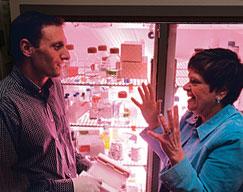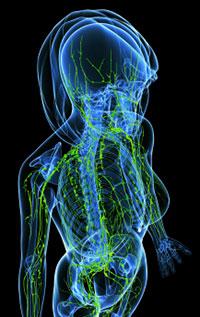
Who Gets Lymphedema After Breast Cancer? Genetic Research Provides Clues
“It’s hard enough to lose your breast and to go through radiation and chemotherapy. Imagine suddenly developing a large limb and having no idea what it is,” says Saskia R.J. Thiadens, founder and executive director of the National Lymphedema Network.
The organization advocates for increased education and research on lymphedema, a chronic and sometimes disabling condition characterized by swelling due to buildup of fluid, usually in a limb.
Thiadens is encouraged by a new study, authored by UC San Francisco School of Nursing’s Christine Miaskowski and Bradley Aouizerat, that uncovers genetic clues that may one day allow clinicians to better predict who will develop lymphedema, increasing the odds that it will be diagnosed and treated in the earliest stages – and, perhaps, prevented.
Lymphedema’s Impact
It’s difficult to pinpoint how many women develop lymphedema after breast cancer – estimates range widely – because clinicians use a variety of methods to measure it, some of them highly dependent upon subjective observation, such as patients’ reports of symptoms. Moreover, says Miaskowski, there’s no consensus on what constitutes a true case: “How much swelling is enough isn’t clear in the literature,” she says. “It’s a science that’s evolving.”
What is clear is that identifying those most likely to develop lymphedema matters because successful treatment depends on early detection and swift, appropriate intervention. Once swelling progresses past a certain point, it may become difficult to reduce, putting patients at higher risk for infection in the affected limb.
Finding Predictors for Lymphedema
 Bradley Aouizerat and Christine Miaskowski The UCSF study is the first to identify both phenotypic (demographic and clinical) characteristics and genetic markers that appear to increase lymphedema risk among women who undergo breast cancer surgery. It came about almost by accident when Miaskowski – associate dean for Academic Affairs at UCSF School of Nursing, American Cancer Society Clinical Research Professor and Sharon A. Lamb Endowed Chair in Symptom Management Research – and her co-investigators were putting together a grant to study persistent pain after breast cancer surgery. Because they were enrolling women prior to surgery and planned to follow them closely afterwards, they decided to add lymphedema to the study to find out how long after surgery it can develop.
Bradley Aouizerat and Christine Miaskowski The UCSF study is the first to identify both phenotypic (demographic and clinical) characteristics and genetic markers that appear to increase lymphedema risk among women who undergo breast cancer surgery. It came about almost by accident when Miaskowski – associate dean for Academic Affairs at UCSF School of Nursing, American Cancer Society Clinical Research Professor and Sharon A. Lamb Endowed Chair in Symptom Management Research – and her co-investigators were putting together a grant to study persistent pain after breast cancer surgery. Because they were enrolling women prior to surgery and planned to follow them closely afterwards, they decided to add lymphedema to the study to find out how long after surgery it can develop.
“The National Cancer Institute was excited,” says Miaskowski, because few previous studies included presurgical baseline measurements for both limbs. It became clear that this was a unique opportunity to get robust data on a common but poorly understood condition.
When they delved further into the literature, Miaskowski and her colleagues realized that to capture most cases, they needed to follow subjects longer than the planned one year after surgery, because lymphedema can develop long after surgery, sometimes years later. They wrote another grant that allowed them to continue to follow the enrolled women for three to five years after surgery, focusing on lymphedema.
They added the genetic component when co-investigator Aouizerat, professor in the Department of Physiological Nursing and a researcher at the UCSF Institute for Human Genetics, joined the team. He and his colleagues targeted several candidate genes known to play a role in primary lymphedema (a form of the condition that occurs spontaneously without prior trauma) to see if variations affected a woman’s chance of developing lymphedema after breast cancer surgery.
The research team used DNA samples taken from women who had undergone surgery in one breast to examine genetic differences between those who did and didn’t develop lymphedema. They identified four gene variations that appeared more frequently among women who were diagnosed with the condition. While the association was significant, Aouizerat cautions, “None [of the genetic variations] alone cause the problem.” An individual may have only one of the variations and still develop lymphedema, or she may have all four and never have a problem.
Several other factors that may increase a woman’s lymphedema risk also emerged from the study: higher body mass index (BMI), later-stage breast cancer and larger number of lymph nodes removed. These data helped confirm similar findings in previous studies and provide additional clues to the mystery of why some women develop the condition.
Moving Towards a Consistent Approach to Lymphedema Screening
Any information that can help predict who is at higher risk is potentially valuable. Thiadens and Miaskowski agree that there’s a great deal of variation in how lymphedema screening, measurement and diagnosis are approached in clinics and physicians’ offices across the country.
The National Lymphedema Network has a position paper on screening women undergoing breast cancer surgery to help ensure lymphedema is diagnosed early, which includes recommendations for several of the methods Miaskowski and her colleagues used in their study: baseline measurements in both arms prior to surgery; use of objective measurements like bioimpedance spectroscopy (which uses tiny electrical pulses to measure fluid buildup) to help identify small, incremental changes; and calculation of patients’ BMI.
The problem is that access to clinics that use these tools isn’t consistently available to all breast cancer patients, says Thiadens. Identifying women at greatest risk before they begin to show symptoms could help ensure they are referred to clinics that have practitioners who are specially trained to diagnose and treat lymphedema.
Paving the Way for Prevention
 Lymphatic system Prevention is the holy grail for most health problems, but current strategies for preventing lymphedema are limited. “There’s a lot of folklore around it,” says Miaskowski. “As a nurse, I was told to tell patients to avoid further injury to the operated side – don’t have bloods drawn or blood pressures taken on that side; if you’re a cook, don’t cut yourself on that side. But it’s really not clear what the secondary triggers are.” Genetic research could pave the way for new preventive therapies targeted at the affected genes in women found to carry the variations that put them at higher risk.
Lymphatic system Prevention is the holy grail for most health problems, but current strategies for preventing lymphedema are limited. “There’s a lot of folklore around it,” says Miaskowski. “As a nurse, I was told to tell patients to avoid further injury to the operated side – don’t have bloods drawn or blood pressures taken on that side; if you’re a cook, don’t cut yourself on that side. But it’s really not clear what the secondary triggers are.” Genetic research could pave the way for new preventive therapies targeted at the affected genes in women found to carry the variations that put them at higher risk.
“If either increasing or decreasing expression of one or more of these genes decreases risk, we might ultimately be able to stop lymphedema before it emerges,” says Aouizerat.
Miaskowski and her colleagues are planning a follow-up study that would recruit an additional 1,500 women to examine the impact of lymphedema on their lives and to expand the list of potential genetic predictors. Says Aouizerat, “Until recently, we thought the lymphatic system was a passive system, but now it’s clear that it’s anything but. There’s a lot more to understand."



